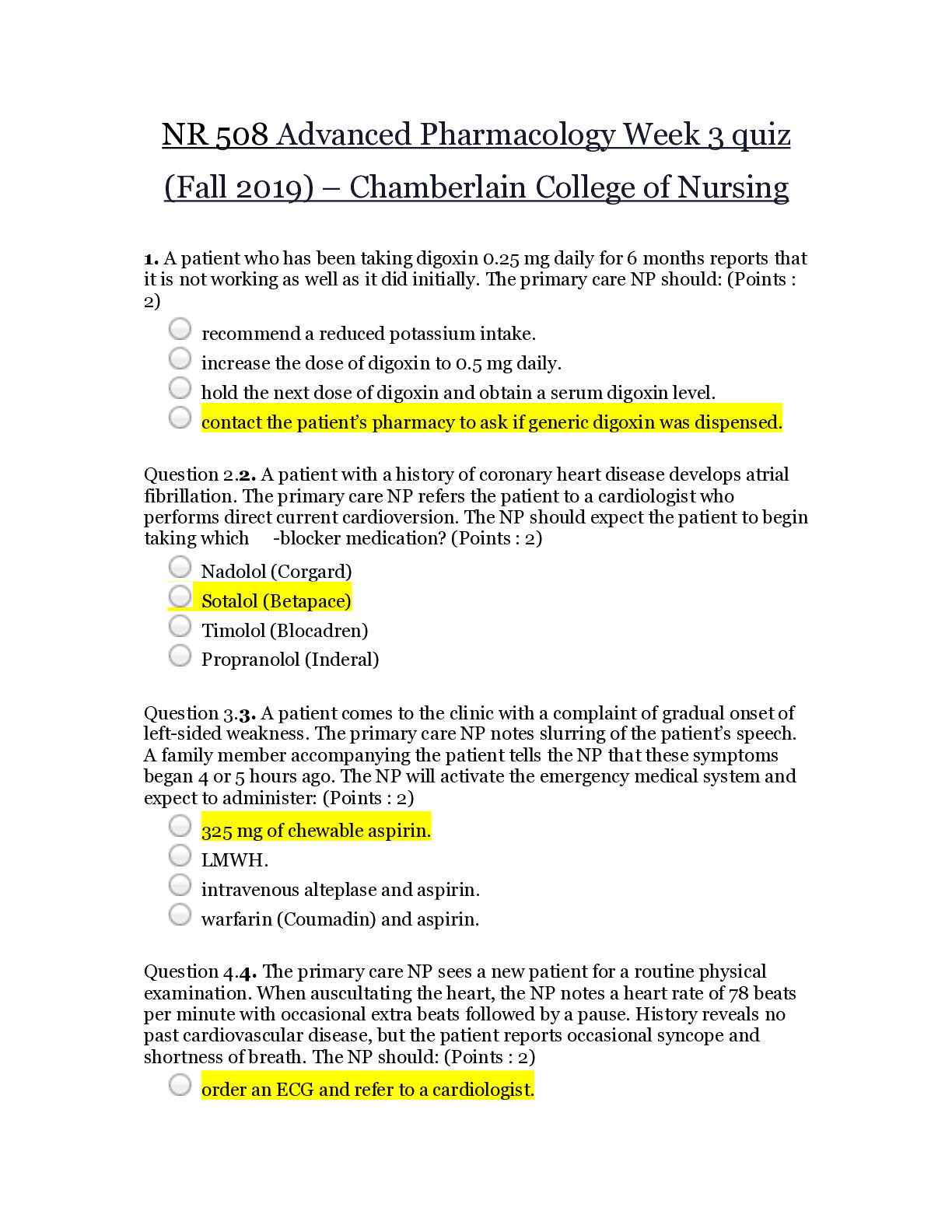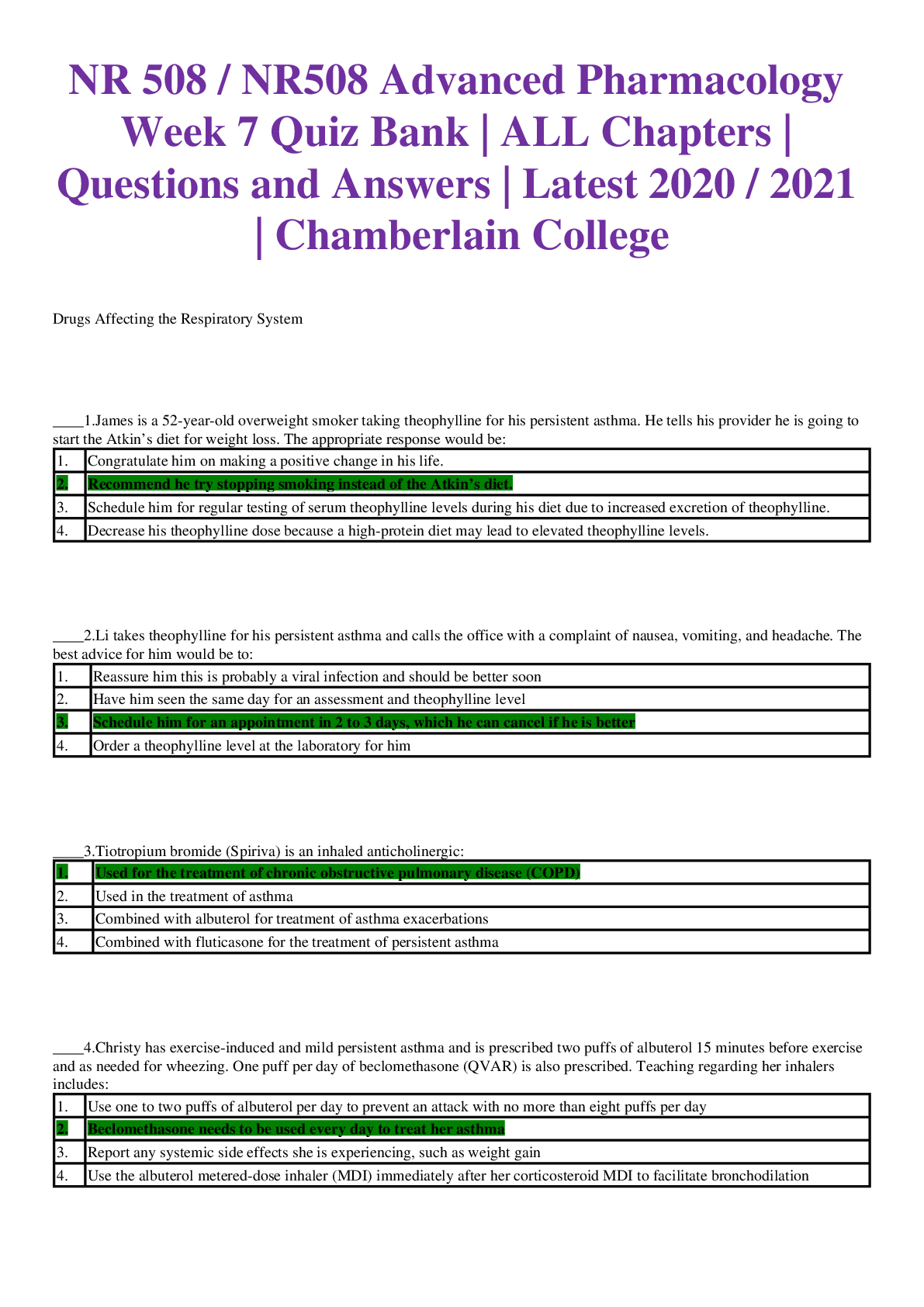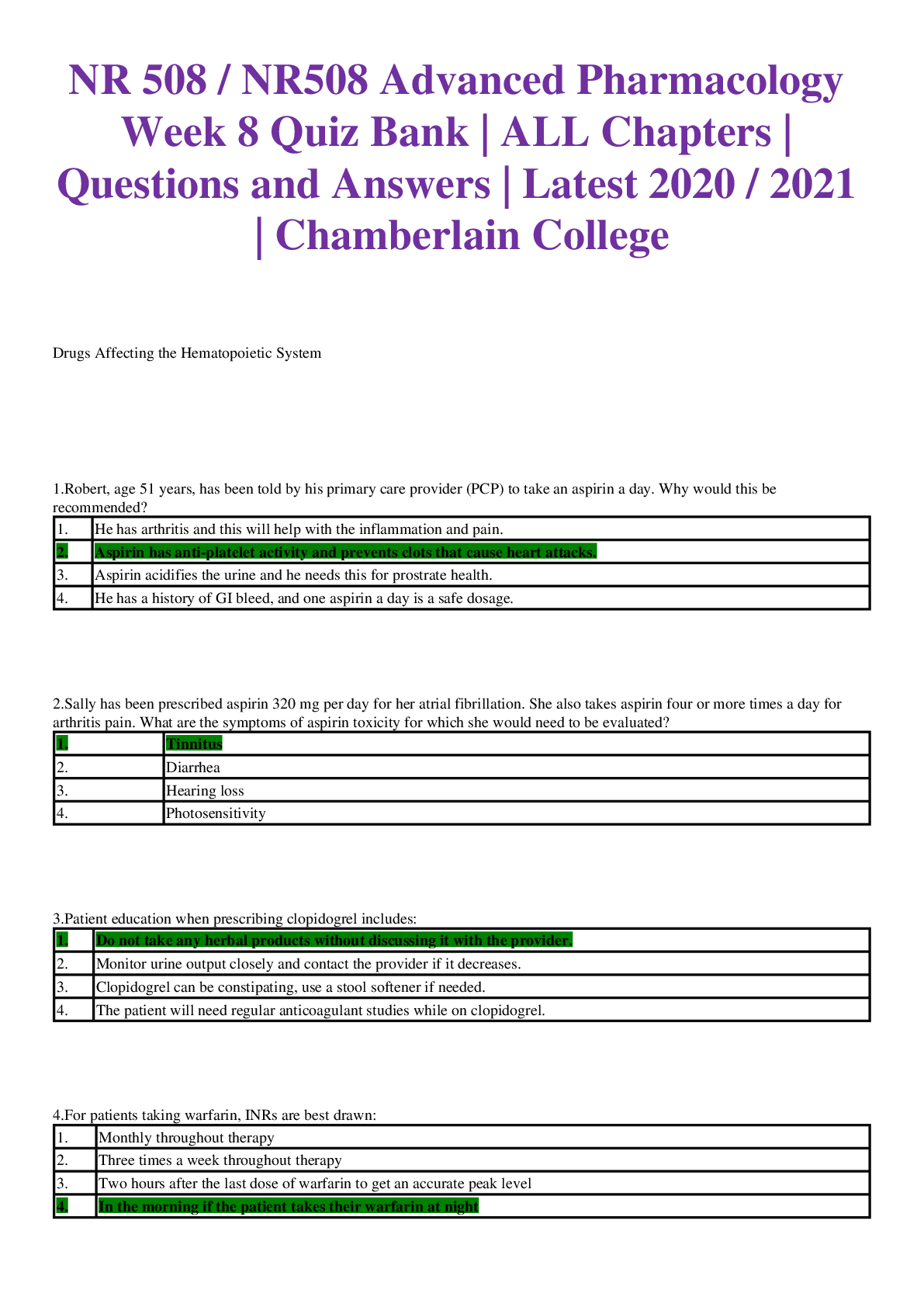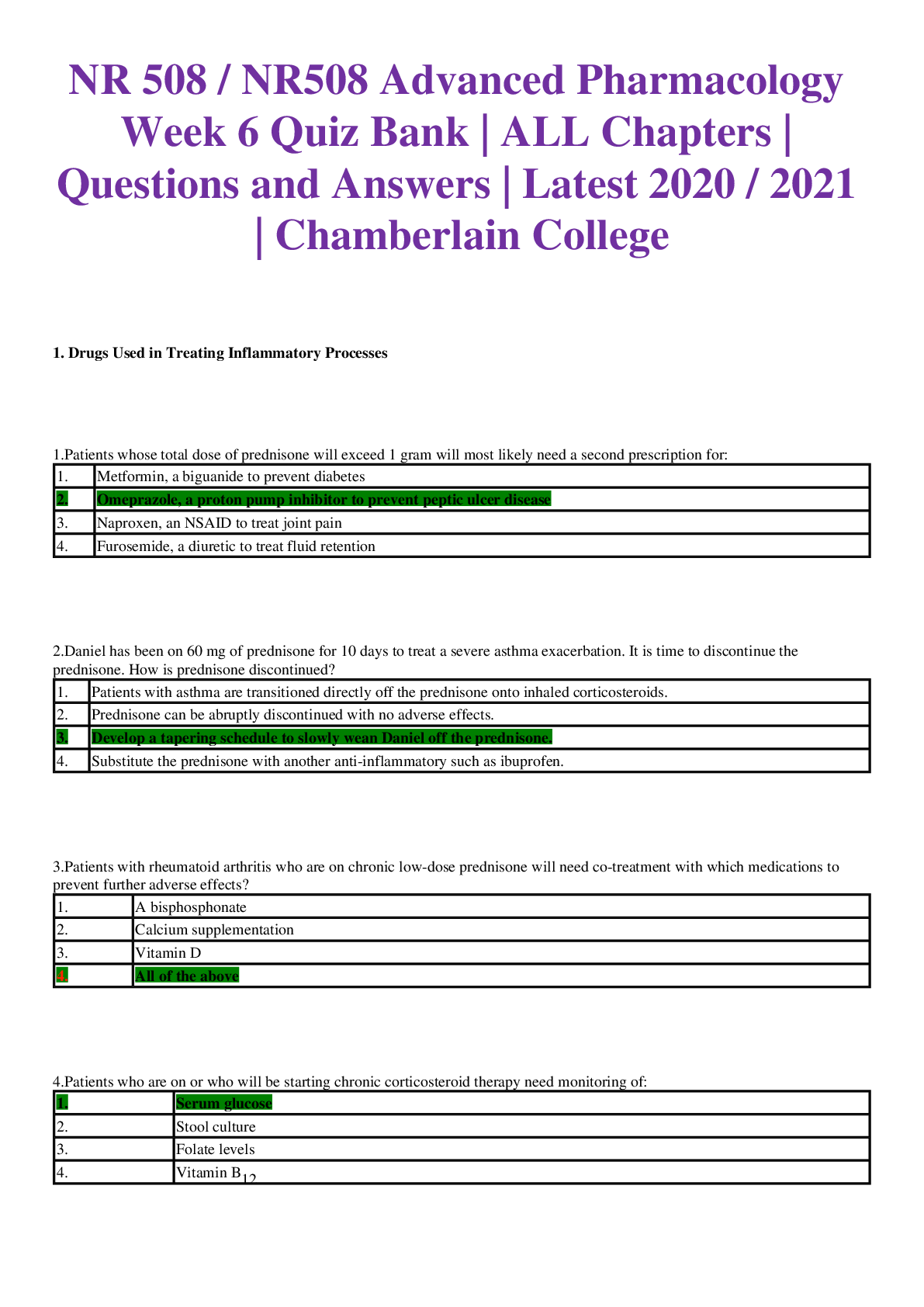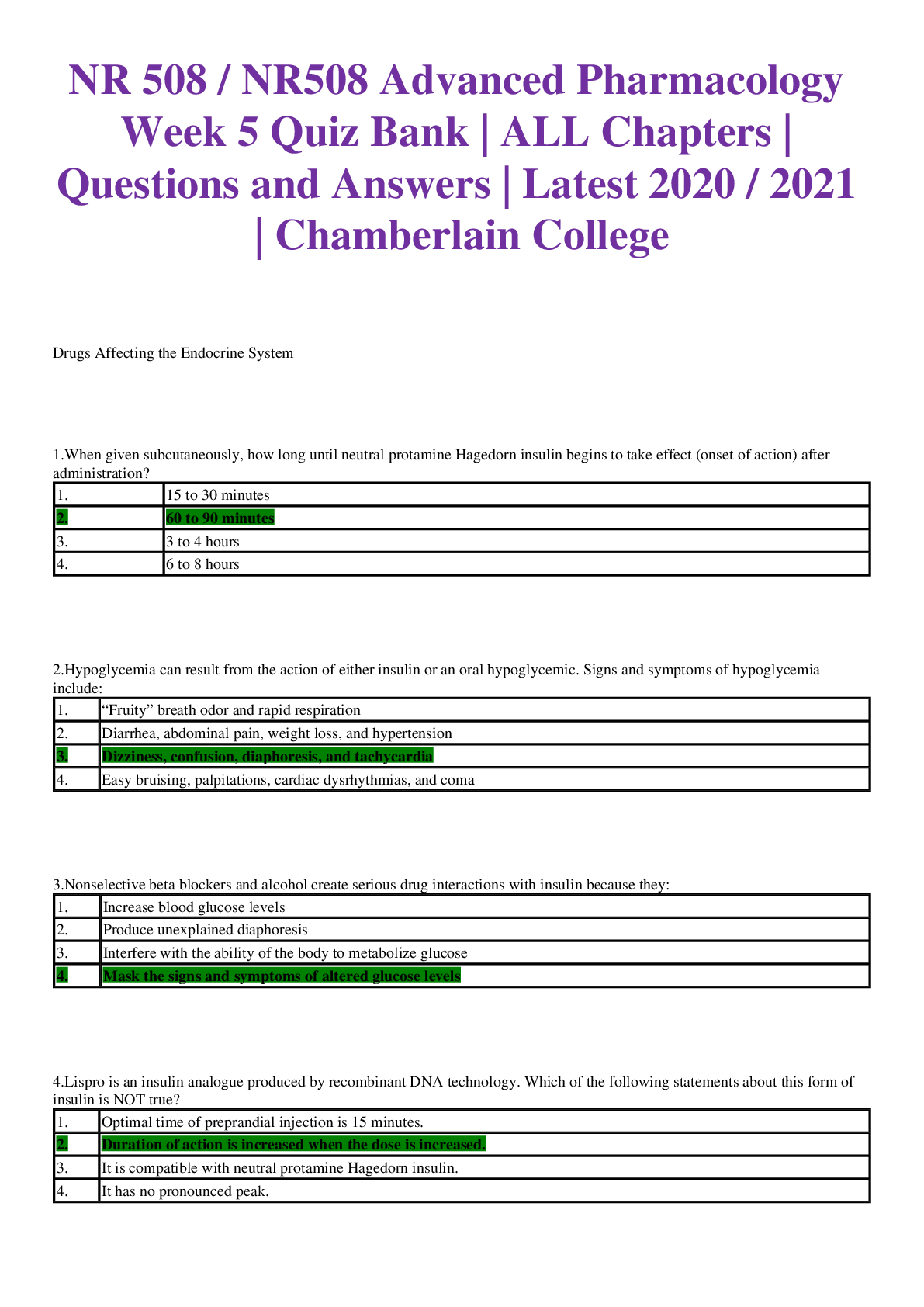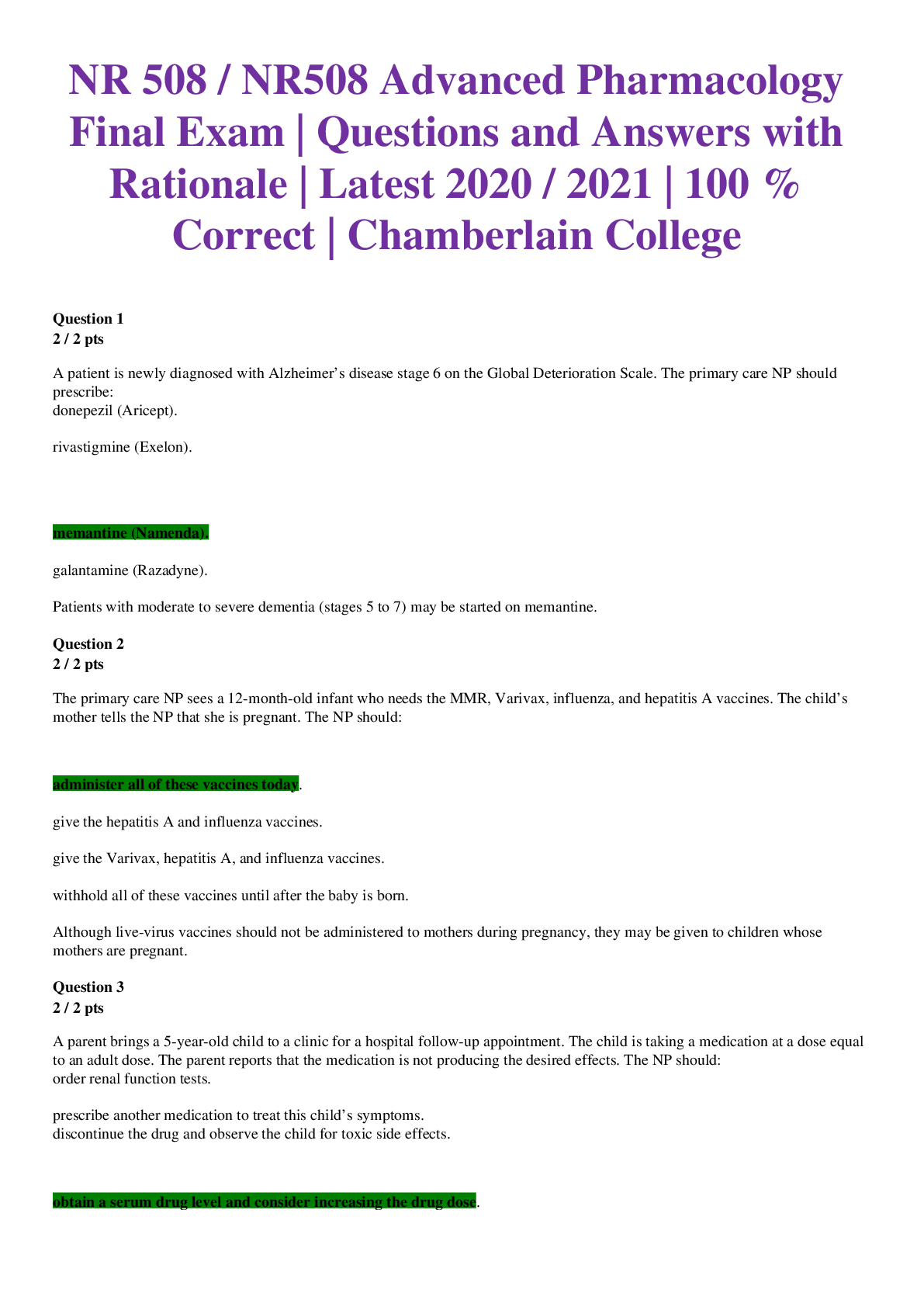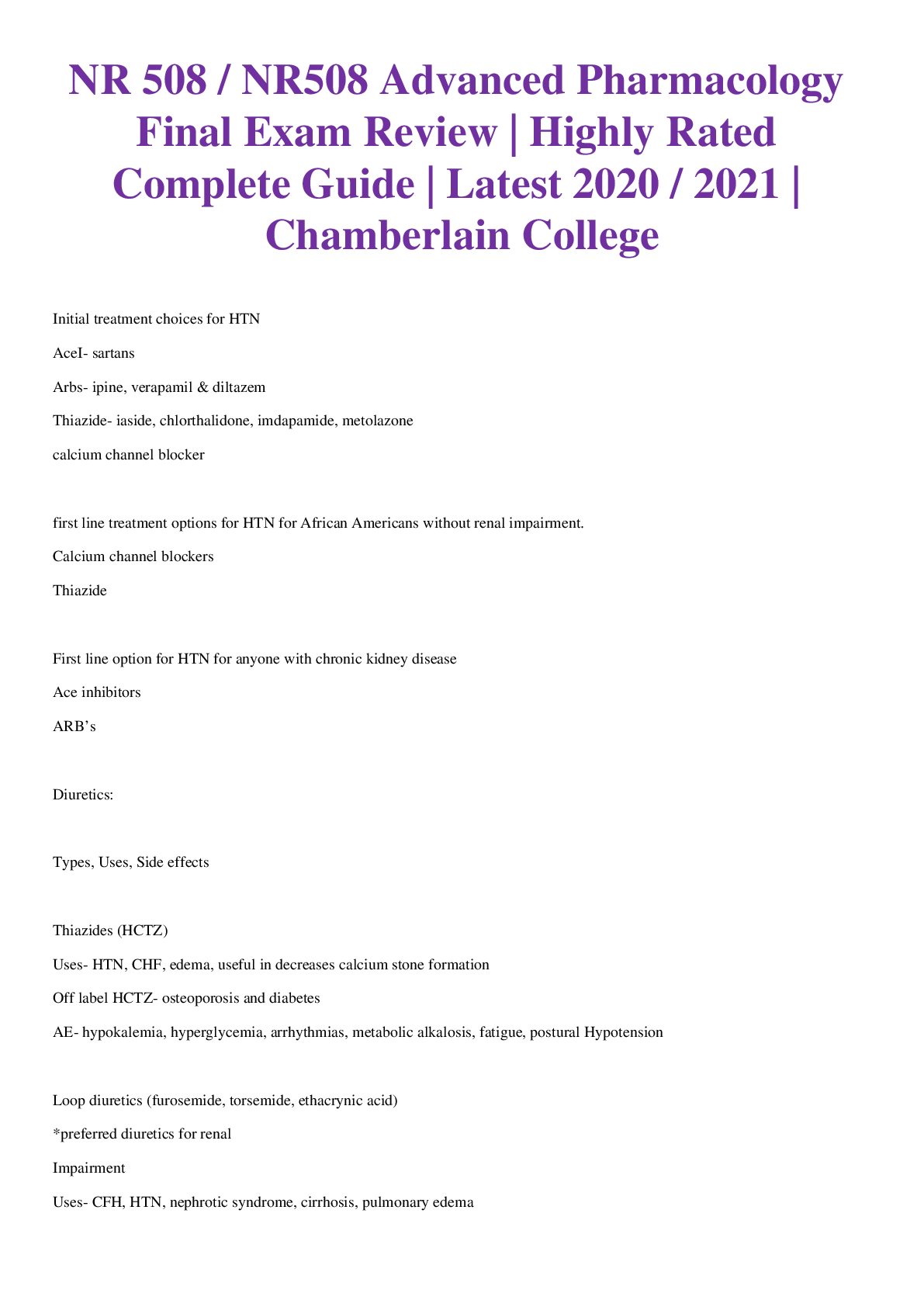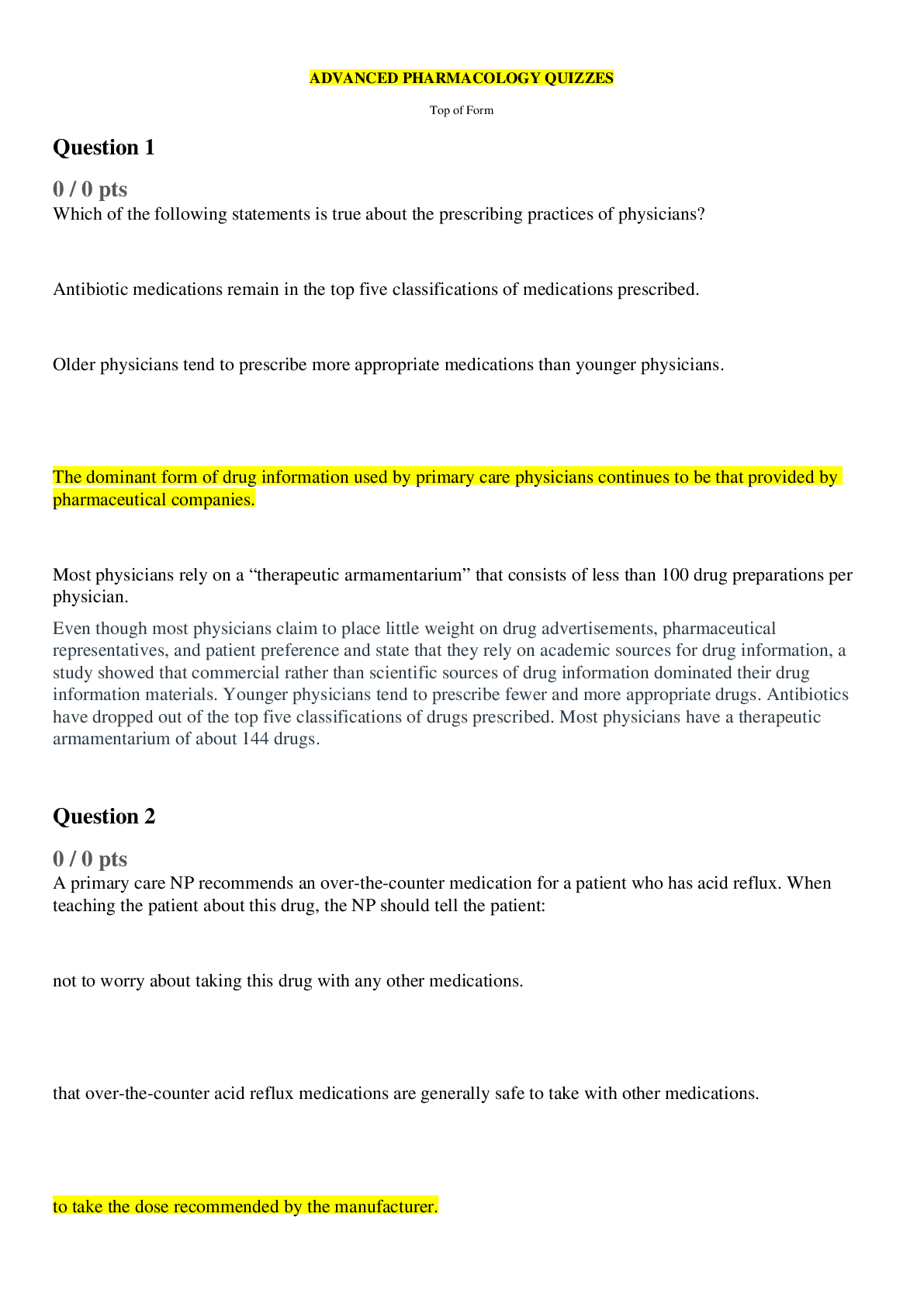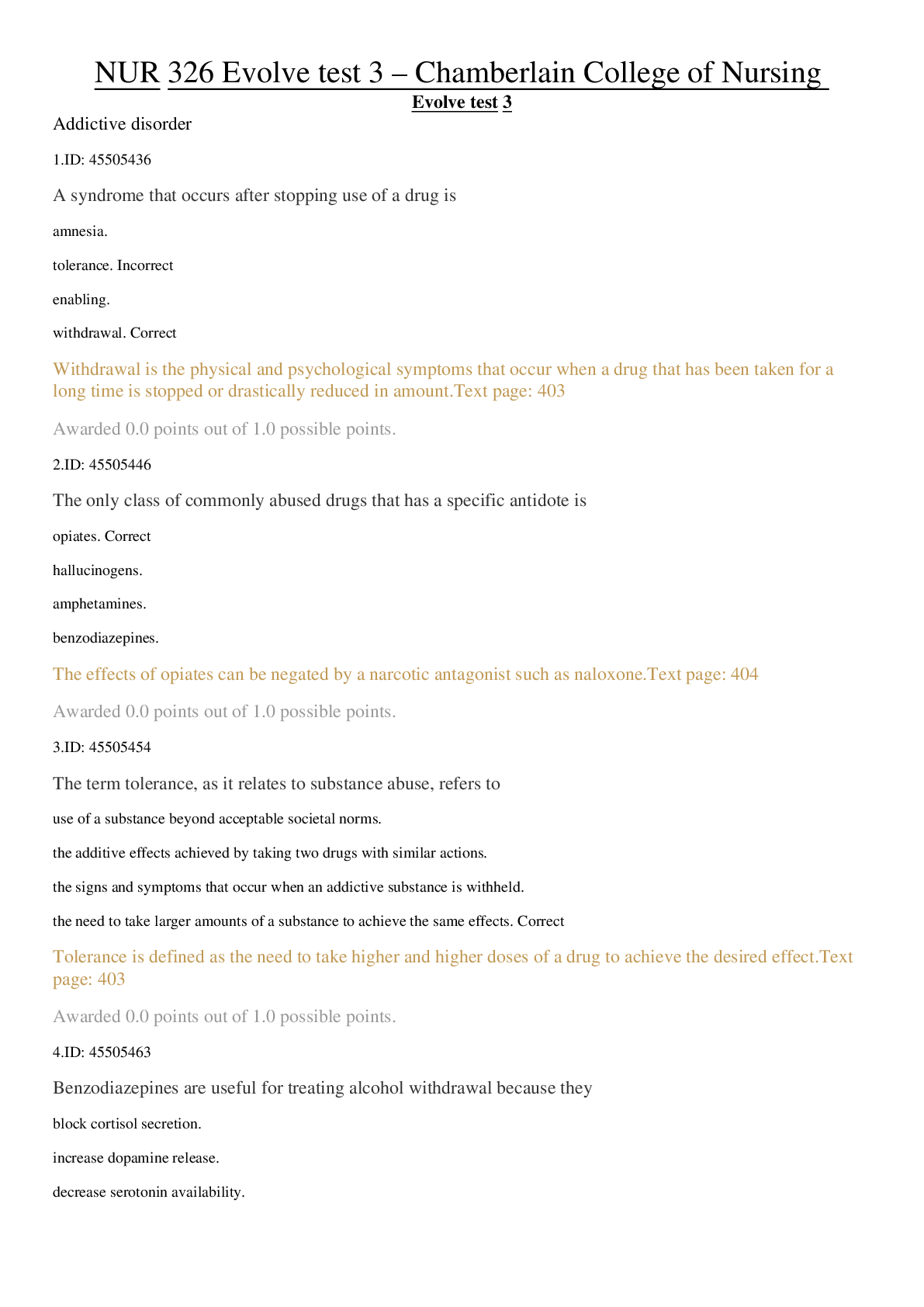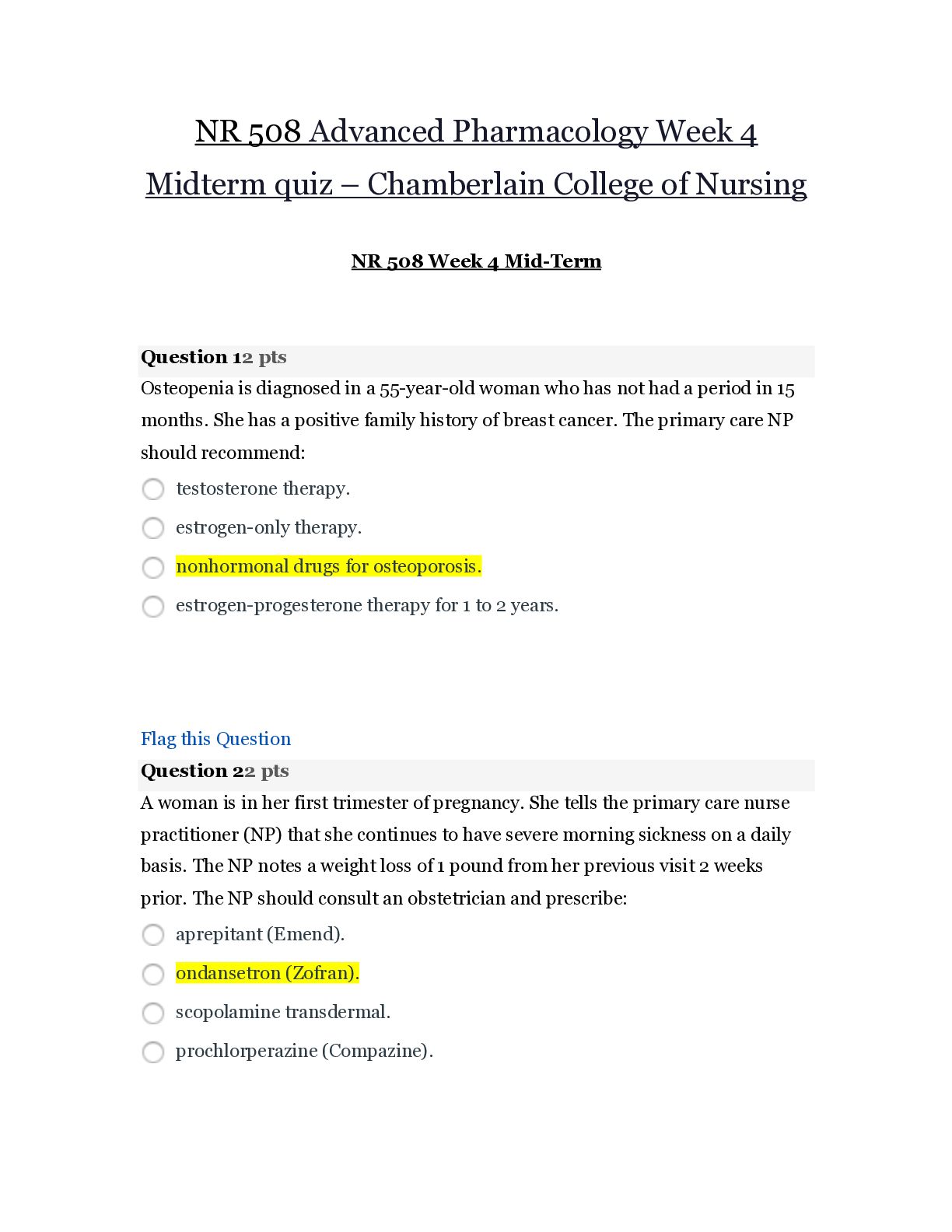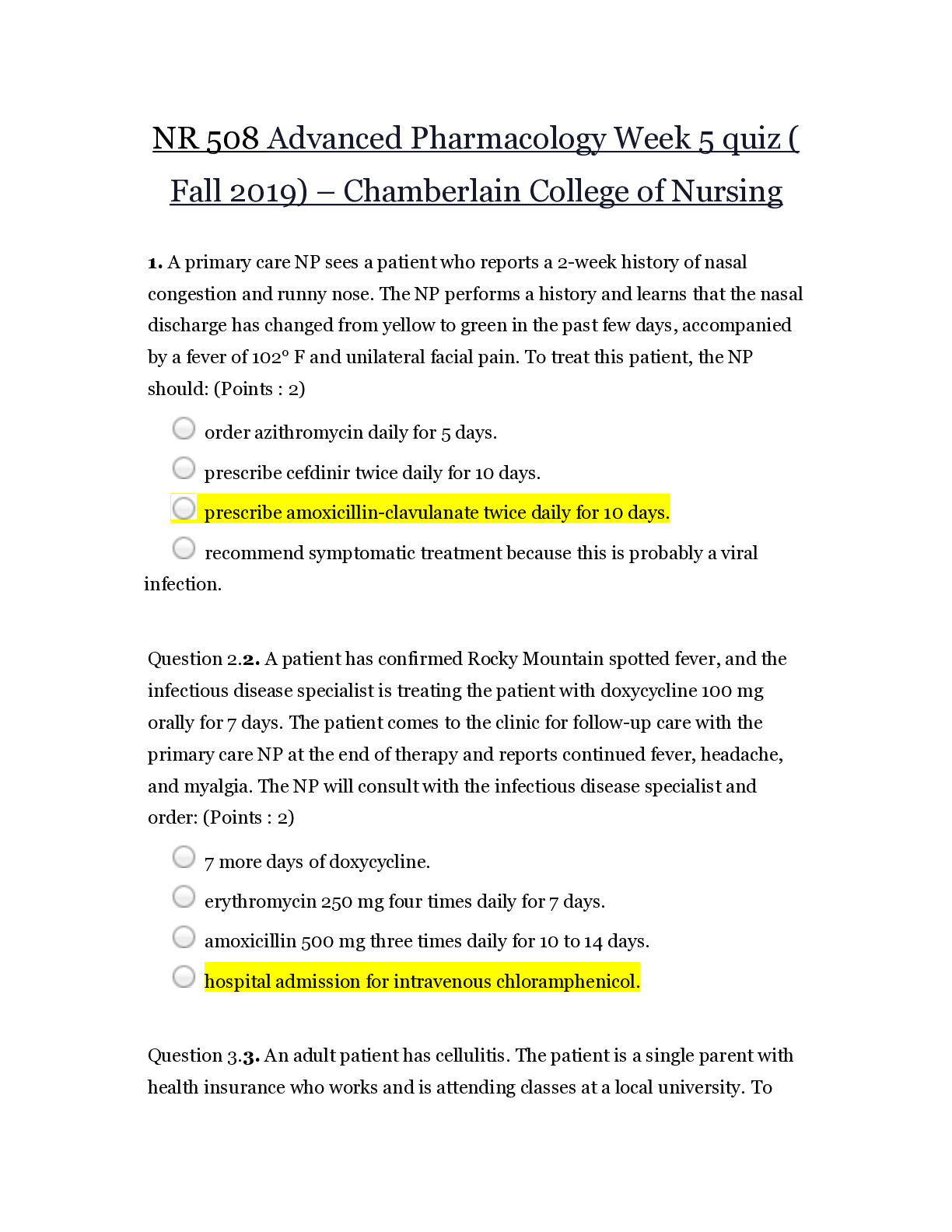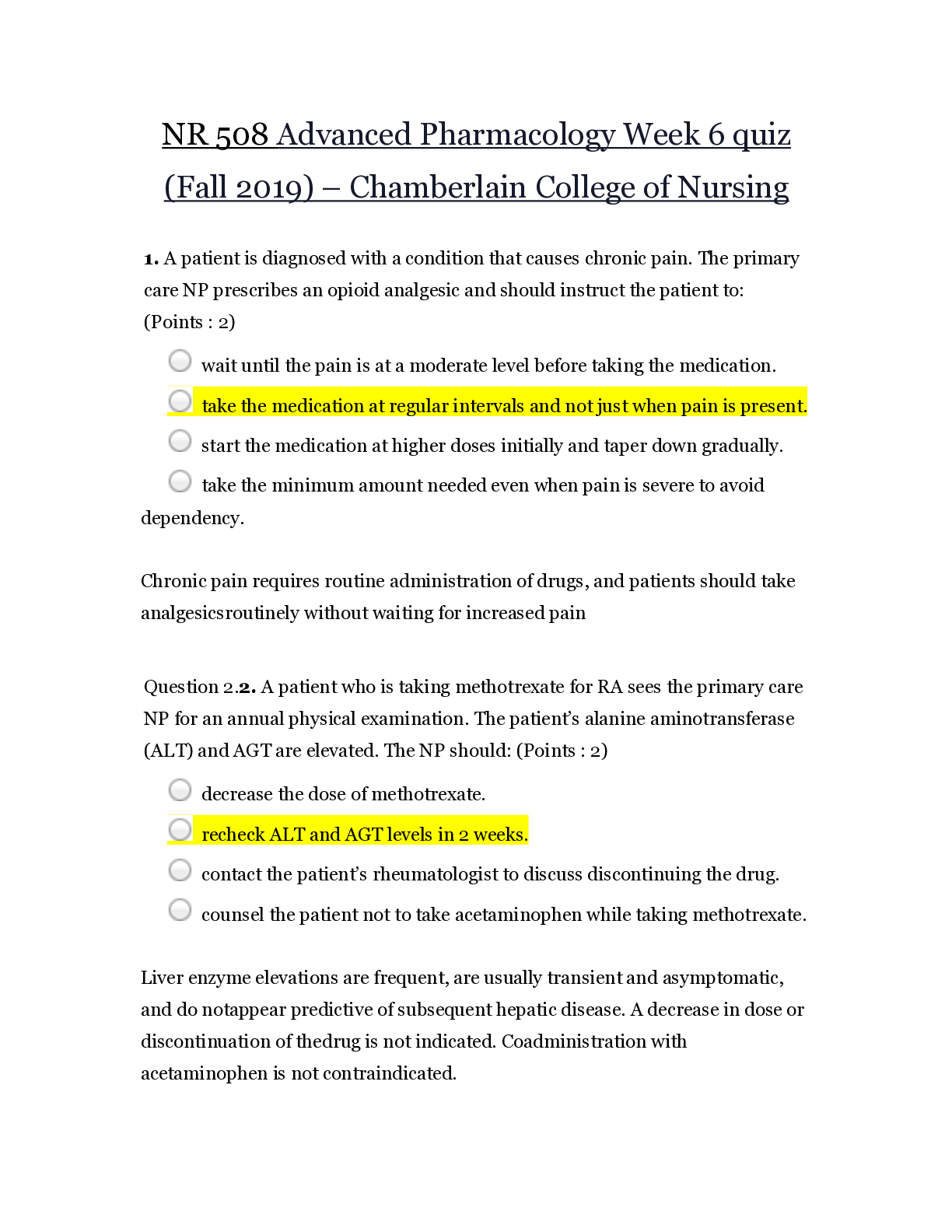Pharmacology > EXAM > NR 508 Advanced Pharmacology Quiz 2 Spring 2019 – Chamberlain College of Nursing / NR508 Advanced (All)
NR 508 Advanced Pharmacology Quiz 2 Spring 2019 – Chamberlain College of Nursing / NR508 Advanced Pharmacology Quiz 2 Spring 2019
Document Content and Description Below
NR 508 Advanced Pharmacology Quiz 2 Spring 2019 – Chamberlain College of Nursing Men who use transdermal testosterone gel (AndroGel) should be advised to avoid: 1. Washing their hands after applyi... ng the gel 2. Wearing occlusive clothing while using the gel 3. Exposure to estrogens while using the gel 4. Skin-to-skin contact with pregnant women while using the gel Education when prescribing androgens to male patients includes advising that: 1. Short-term use places the patient at risk for hepatocellular carcinoma. 2. Cholestatic hepatitis and jaundice may occur with low doses of androgens. 3. Gynecomastia is a rare occurrence with the use of androgens. 4. Low sperm levels only occur with long-term use of androgens. Patients who are prescribed exogenous androgens need to be warned that decreased libido: 1. Is an unusual side effect of androgens and should be reported to the provider 2. Is treated with increased doses of androgens, so the patient should let the provider know if he is having problems 3. May be a sign of early prostate cancer and he should make an appointment for a prostate screening exam 4. May occur with androgen therapy The U.S. Food and Drug Administration warns that androgens may cause: 1. Peliosis hepatis 2. Orthostatic hypotension 3. Menstrual irregularities 4. Acne Monitoring for a patient who is using androgens includes evaluation of: 1. Complete blood count and C-reactive protein levels 2. Lipid levels and liver function tests 3. Serum potassium and magnesium levels 4. Urine protein and potassium levels Male patients require ______________________ before and during androgen therapy. 1. A digital prostate exam 2. A Doppler exam of testicular blood flow 3. Urine analysis for proteinuria 4. Serial orthostatic blood pressures Absolute contraindications to estrogen therapy include: 1. History of any type of cancer 2. Clotting disorders 3. History of tension headaches 4. Orthostatic hypotension Postmenopausal women with an intact uterus should not be prescribed: 1. Estrogen/progesterone combination 2. IM medroxyprogesterone (Depo Provera) 3. Estrogen alone 4. Androgens Women who have migraines with an aura should not be prescribed estrogen because of: 1. The interaction between triptans and estrogen, limiting migraine therapy choices 2. An increased incidence of migraines with the use of estrogen 3. An increased risk of stroke occurring with estrogen use 4. Patients with migraines may be prescribed estrogen without any concerns A 22-year-old woman receives a prescription for oral contraceptives. Education for this patient includes: 1. Counseling regarding decreasing or not smoking while taking oral contraceptives 2. Advising a monthly pregnancy test for the first 3 months she is taking the contraceptive 3. Advising that she may miss two pills in a row and not be concerned about pregnancy 4. Recommending that her next follow-up visit is in 1 year for a refill and annual exam A 19-year-old female is a nasal Staph aureus carrier and is placed on 5 days of rifampin for treatment. Her only other medication is combined oral contraceptives. What education should she receive regarding her medications? 1. Separate the oral ingestion of the rifampin and oral contraceptive by at least an hour. 2. Both medications are best tolerated if taken on an empty stomach. 3. She should use a back-up method of birth control such as condoms for the rest of the current pill pack. 4. If she gets nauseated with the medications she should call the office for an antiemetic prescription. A 56-year-old woman is complaining of vaginal dryness and dyspareunia. To treat her symptoms with the lowest adverse effects she should be prescribed: 1. Low-dose oral estrogen 2. A low-dose estrogen/progesterone combination 3. A vaginal estradiol ring 4. Vaginal progesterone cream Shana is receiving her first medroxyprogesterone (Depo Provera) injection. Shana will need to be monitored for: 1. Depression 2. Hypertension 3. Weight loss 4. Cataracts When prescribing medroxyprogesterone (Depo Provera) injections, essential education would include advising of the following potential adverse drug effects: 1. Hypertension and dysuria 2. Depression and weight gain 3. Abdominal pain and constipation 4. Orthostatic hypotension and dermatitis The medroxyprogesterone (Depo Provera) injection has a Black Box Warning due to: 1. The potential development of significant hypertension 2. Increased risk of strokes 3. Decreased bone density 4. The risk of a life-threatening rash such as Stevens-Johnson Shana received her first medroxyprogesterone (Depo Provera) injection 6 weeks ago and calls the clinic with a concern that she has been having a light "period" off and on since receiving her Depo shot. What would be the management of Shana? 1. Reassurance that some spotting is normal the first few months of Depo and it should improve. 2. Schedule an appointment for an exam as this is not normal. 3. Prescribe 4 weeks of estrogen to treat the abnormal vaginal bleeding. 4. Order a pregnancy test and suggest she use a back-up method of contraception until she has her next shot. William is a 62-year-old male who is requesting a prescription for sildenafil (Viagra). He should be screened for ________________ before prescribing sildenafil. 1. Renal dysfunction 2. Unstable coronary artery disease 3. Benign prostatic hypertrophy 4. History of priapism Men who are prescribed sildenafil (Viagra) need ongoing monitoring for: 1. Development of chest pain or dizziness 2. Weight gain 3. Priapism 4. Renal function Men who are prescribed an erectile dysfunction drug such as sildenafil (Viagra) should be warned about the risk for: 1. Impotence when combined with antihypertensives 2. Fatal hypotension if combined with nitrates 3. Weight gain if combined with antidepressants 4. All of the above Androgens are indicated for: 1. Symptomatic treatment for male deficiency 2. Female libido, endometriosis, and postmenopausal symptoms 3. Increased muscle mass 4. Symptomatic treatment in both sexes for cancer and HIV 5. 1, 2, and 4 6. All of the above Long-term use of androgens requires specific laboratory monitoring of: 1. Glucose, calcium, testosterone, and thyroid function 2. Calcium, testosterone, PSA, and liver function 3. Calcium, testosterone, PSA, liver function, glucose, and lipids 4. CBC, testosterone, PSA, and thyroid level Effects of estrogen include: 1. Regulation of the menstrual cycle 2. Maintenance of bone density by increasing bone reabsorption 3. Maintenance of the normal structure of the skin and blood vessels 4. A and C 5. All of the above Absolute contraindications that clinicians must consider when initiating estrogen therapy include: 1. Undiagnosed dysfunctional uterine bleeding 2. Deep vein or arterial thromboemboli within the prior year 3. Endometriosis 4. 1 and 2 5. All of the above Patients taking hormonal contraceptives and hormone replacement therapy need to take the drug daily at the same time to prevent: 1. Nausea 2. Breakthrough bleeding 3. Breast tenderness 4. Pregnancy Women who are taking an oral contraceptive containing the progesterone drospirenone may require monitoring of: 1. Hemoglobin 2. Serum calcium 3. White blood count 4. Serum potassium The mechanism of action of oral combined contraceptives that prevents pregnancy is: 1. Estrogen prevents the luteinizing hormone surge necessary for ovulation. 2. Progestins thicken cervical mucus and slow tubal motility. 3. Estrogen thins the endometrium making implantation difficult. 4. Progestin suppresses follicle stimulating hormone release. To improve actual effectiveness of oral contraceptives women should be educated regarding: 1. Use of a back-up method if they have vomiting or diarrhea during a pill packet 2. Doubling pills if they have diarrhea during the middle of a pill pack 3. The fact that they will have a normal menstrual cycle if they miss two pills 4. The fact that mid-cycle spotting is not normal and the provider should be contacted immediately A contraindication to the use of combined contraceptives is: 1. Adolescence (not approved for this age) 2. A history of clotting disorder 3. Recent pregnancy 4. Being overweight Obese women may have increased risk of failure with which contraceptive method? 1. Combined oral contraceptives 2. Progestin-only oral contraceptive pill 3. Injectable progestin 4. Combined topical patch Ashley comes to the clinic with a request for oral contraceptives. She has successfully used oral contraceptives before and has recently started dating a new boyfriend so would like to restart contraception. She denies recent intercourse and has a negative urine pregnancy test in the clinic. An appropriate plan of care would be: 1. Recommend she return to the clinic at the start of her next menses to get a Depo Provera shot. 2. Prescribe oral combined contraceptives and recommend she start them at the beginning of her next period and use a back-up method for the first 7 days. 3. Prescribe oral contraceptives and have her start them the same day as the visit with a back-up method used for the first 7 days. 4. Discuss the advantages of using the topical birth control patch and recommend she consider using the patch. When discussing with a patient the different start methods used for oral combined contraceptives, the advantage of a Sunday start over the other start methods is: 1. Immediate protection against pregnancy the first week of using the pill 2. No back-up method is needed when starting 3. Menses occur during the week 4. They can start the pill on the Sunday after the office visit The topical patch combined contraceptive (Ortho Evra) is: 1. Started on the first day of the menstrual cycle 2. Recommended for women over 200 pounds 3. Not as effective as oral combined contraceptives 4. Known to have more adverse effects, such as nausea, than the oral combined contraceptives Progesterone-only pills are recommended for women who: 1. Are breastfeeding 2. Have a history of migraine 3. Have a medical history that contradicts the use of estrogen 4. All of the above Women who are prescribed progestin-only contraception need education regarding which common adverse drug effects? 1. Increased migraine headaches 2. Increased risk of developing blood clots 3. Irregular vaginal bleeding for the first few months 4. Increased risk for hypercalcemia An advantage of using the NuvaRing vaginal ring for contraception is: 1. It does not require fitting and is easy to insert. 2. It is inserted once a week, eliminating the need to remember to take a daily pill. 3. Patients get a level of estrogen and progestin equal to combined oral contraceptives. 4. It also provides protection against vaginal infections. Oral emergency contraception (Plan B) is contraindicated in women who: 1. Had intercourse within the past 72 hours 2. May be pregnant 3. Are taking combined oral contraceptives 4. Are using a diaphragm The goals of treatment when prescribing for sexually transmitted infections include: 1. Treatment of infection 2. Prevention of disease spread 3. Prevention of long-term sequelae from the infection 4. All of the above The drug of choice for treatment of primary or secondary syphilis is: 1. Ceftriaxone IM 2. Benzathine penicillin G IM 3. Oral azithromycin 4. Oral ciprofloxacin The drug of choice for treatment of early latent or tertiary syphilis is: 1. Ceftriaxone IM 2. Benzathine penicillin G IM 3. Oral azithromycin 4. Oral ciprofloxacin Demione is a 24-year-old patient who is 32 weeks pregnant and has tested positive for syphilis. The best treatment for her would be: 1. IM ceftriaxone 2. IM benzathine penicillin G 3. Oral azithromycin 4. Any of the above Treatment for suspected gonorrhea is: 1. Ceftriaxone 250 mg IM x 1 2. Ceftriaxone 2 grams IM x 1 3. Ciprofloxacin 500 mg PO x 1 4. Doxycycline 100 mg bid x 7 days When treating suspected gonorrhea in a nonpregnant patient, the patient should be concurrently treated for chlamydia with: 1. Azithromycin 1 gram PO x 1 2. Amoxicillin 500 mg PO x 1 3. Ciprofloxacin 500 mg PO x 1 4. Penicillin G 2.4 million units IM x 1 Ongoing monitoring is essential after treating for gonorrhea. The patient should be rescreened for gonorrhea and chlamydia in: 1. 4 weeks 2. 3 to 6 weeks 3. 3 to 6 months 4. 1 year A test of cure is recommended after treating chlamydia in which patient population? 1. Men who have sex with men 2. Adolescent females 3. Pregnant patients 4. All of the above Treatment for chancroid in a nonpregnant patient would be: 1. Oral azithromycin 2. IM ceftriaxone 3. Oral ciprofloxacin 4. Any of the above Jamie was treated for chancroid. Follow-up testing after treatment of chancroid would be: 1. Syphilis and HIV testing at 3-month intervals 2. Chancroid-specific antigen test every 3 months 3. Urine testing for Haemophilus ducreyi in 3 to 6 months for test of cure 4. Annual HIV testing if engaging in high-risk sexual behavior Helima presents with a complaint of vaginal discharge that when tested meets the criteria for bacterial vaginosis. Treatment of bacterial vaginosis in nonpregnant symptomatic women would be: 1. Metronidazole 500 mg PO bid x 7 days 2. Doxycycline 100 mg PO bid x 7 days 3. Intravaginal tinidazole daily x 5 days 4. Metronidazole 2 grams PO x 1 dose Besides prescribing antimicrobial therapy, patients with bacterial vaginosis require education regarding the fact that: 1. The most recent partners in the past 60 days should also be treated. 2. Alcohol should not be consumed during and for 1 day after metronidazole is taken. 3. Condoms should be used during intercourse if intravaginal clindamycin cream is used. 4. Co-treatment for chlamydia is necessary. Sydney presents to the clinic with vulvovaginal candidiasis. Appropriate treatment for her would be: 1. OTC intravaginal clotrimazole 2. OTC intravaginal miconazole 3. Oral fluconazole one-time dose 4. Any of the above If a woman presents with recurrent vulvovaginal candidiasis she may be treated with: 1. Weekly intravaginal butoconazole for 3 months 2. Fluconazole 150 mg PO daily x 7 doses then monthly for 6 months 3. Weekly fluconazole 150 mg PO x 6 months 4. Intravaginal tioconazole x 14 days Zoe presents with genital warts present on her labia. Patient-applied topical therapy for warts includes: 1. Podofilox 0.5% gel 2. Podophyllin 10% resin 3. Trichloracetic acid 4. Any of the above Sophie presents to the clinic with a malodorous vaginal discharge and is confirmed to have Trichomonas infection. Treatment for her would include: 1. Metronidazole 2 grams PO x 1 dose 2. Topical intravaginal metronidazole daily x 7 days 3. Intravaginal clindamycin daily x 7 days 4. Azithromycin 2 grams PO x 1 dose In addition to antimicrobial therapy, patients treated for Trichomonas infection should be educated regarding: 1. Necessity of treating sexual partner simultaneously 2. Abstaining from intercourse until both partners are treated 3. Need for retesting in 3 months due to high reinfection rate 4. All of the above Prescribing for women during their childbearing years requires constant awareness of the possibility of: 1. Pregnancy unless the women is on birth control 2. Risk for silent bacterial or viral infections of the genitalia 3. High risk for developmental disorders in their infants 4. Decreased risk for abuse during this time Intimate partner violence is a serious public health problem. It should be screened for: 1. At every encounter within the health-care system 2. When a women is being seen for symptoms of depression 3. Throughout pregnancy 4. If a sexually transmitted disease is diagnosed Because of their longer life expectancy, women are more likely than men to experience a disabling condition. Common conditions in older women that can produce disability include: 1. Depression 2. Panic disorders 3. Dementia 4. All of the above Gender differences between men and women in pharmacokinetics include: 1. More rapid gastric emptying so that drugs absorbed in the stomach have less exposure to absorption sites 2. Higher proportion of body fat so that lipophilic drugs have relatively greater volumes of distribution 3. Increased levels of bile acids so that drugs metabolized in the intestine have higher concentrations 4. Slower organ blood flow rates so drugs tend to take longer to be excreted Which of the following drug classes is associated with significant differences in metabolism based on gender? 1. Beta blockers 2. Antibiotics 3. Serotonin reuptake inhibitors 4. Angiotensin-converting-enzyme (ACE) inhibitors Since 40% of bone accrual occurs during adolescence, building bone during this time is critical. Ways to improve bone accrual in adolescents include: 1. Use of bisphosphonates early if dual energy X-ray absorptiometry (DEXA) scans show limited bone accrual 2. Encouraging a daily dietary intake of 1,300 mg of calcium and 400 IU of vitamin D 3. Avoiding all birth control methods that include progesterone 4. Fostering the intake of iron mainly in green and leafy vegetables Hot flashes are often a concern during menopause. Which of the following may help in reducing them? 1. Drink one caffeinated liquid per day 2. Take progesterone supplementation 3. Exercise 20-40 minutes/day 4. Increase intake of carrots, yams, and soy products Factors common in women that can affect adherence to a treatment regimen include all of the following EXCEPT: 1. Number of drugs taken: Women tend to take fewer drugs over longer periods of time 2. Fear that medications can cause disease: Information obtained from social networks may be inaccurate for a specific woman 3. Nutritional status: Worries about possible weight gain from a given drug may result in nonadherence 4. Religious differences: A patient's belief system that is not congruent with the treatment regimen presents high risk for nonadherence Dysmenorrhea is one of the most common gynecological complaints in young women. The first line of drug treatment for this disorder is: 1. Oral contraceptive pills 2. Caffeine 3. NSAIDs 4. Aspirin Premenstrual dysphoric disorder (PMDD) occurs in a fairly small number of patients. Theories of the pathology behind PMDD that are supported in research include: 1. Altered sensitivity in the serontonic system 2. Inhibition of the cyclooxygenase system 3. Fluctuations of the gonadal hormones 4. All of these are theories supported by research Treatment of PMDD that affects all or most of the symptoms includes: 1. Tryptophan up to 6 g/d 2. Vitamin E 200-400 mg/d 3. Evening primrose oil 500 mg/d 4. Fluoxetine 20 mg/d Women are now the fastest growing population with HIV infection and AIDS. HIV-infected women: 1. Are less likely to become pregnant or to carry a pregnancy to term 2. Have higher rates of cervical dysplasia and HPV-concurrent infections 3. Are most often over 35 years of age 4. Most often come from Asian and Caucasian ethnic groups Maternal-to-child transmission of HIV infection during pregnancy may be prevented by: 1. Use of antiviral drugs such as zidovudine 2. Use of condoms during intercourse 3. Both 1 and 2 4. Neither 1 nor 2 Erroneous information about LGBTQ individuals can lead to failure to give accurate advice to them as patients. Which of the following statements is true about lesbians: 1. Lesbians cannot contract a sexually transmitted infection from their female partner. 2. Screening for cervical cancer is not required. 3. Lesbians as a group are less likely to have health-care insurance. 4. Like women in general, lesbians are more likely than gay men to seek care for health-related issues. Which of the following holds true for the pharmacokinetics of women? 1. Gastric emptying is faster than that of men. 2. Organ blood flow is the same as that of men. 3. Evidence is strong concerning renal differences in elimination. 4. Medications that involve binding globulins are impacted by estrogen levels. The metabolism of drugs in women is primarily impacted by: 1. Hepatic blow flow 2. Enzymes of the CYP450 system differences with men 3. The amount of gastric secretions 4. Whether they are pre- or postmenopausal The interpretation of DEXA scores in the rare cases of adolescent osteoporosis in teens: 1. Use the same T scores that are established for women 2. Cannot be done because of less-than-mature bones 3. Must use special Z-scores developed for this reason 4. Can only be done if bisphosphonates have already been started The timing of NSAIDS for best control of severe menstrual cramps includes: 1. Taking them for 2-3 days prior to the start of bleeding 2. Taking them 2-3 times a day during the first 2 days 3. Taking them every 2-3 hours 4. They have not been found to be helpful at all Which of the following is true concerning lesbian health concerns? 1. They cannot contract an STI from another woman. 2. Pap smears are not required to screen for cervical cancer. 3. Lesbian women have a tendency to be frequent clinic visitors. 4. The health risks associated with smoking, alcohol, and depression are higher than in the heterosexual population. [Show More]
Last updated: 1 year ago
Preview 1 out of 22 pages
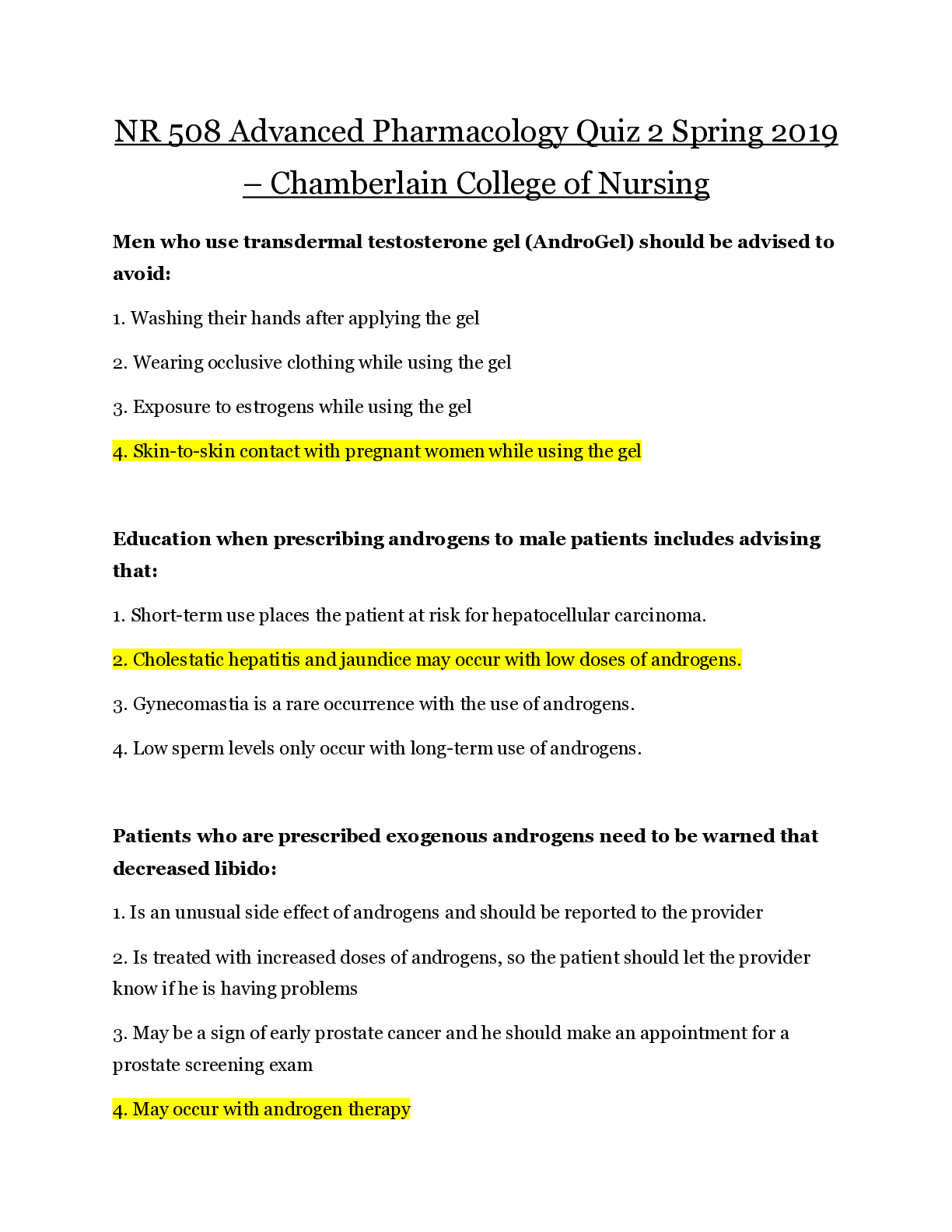
Reviews( 0 )
Document information
Connected school, study & course
About the document
Uploaded On
Jun 03, 2020
Number of pages
22
Written in
Additional information
This document has been written for:
Uploaded
Jun 03, 2020
Downloads
0
Views
43


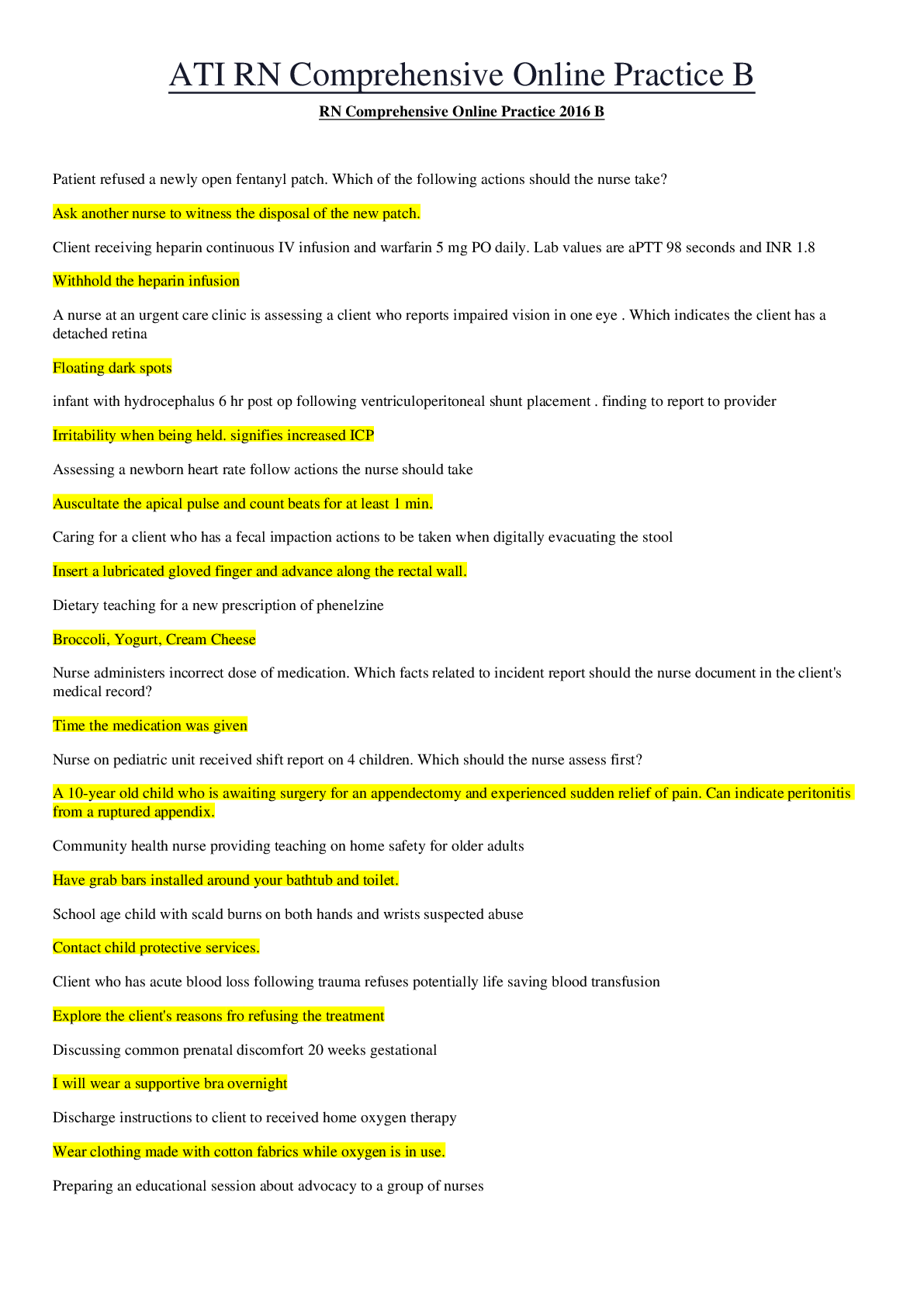
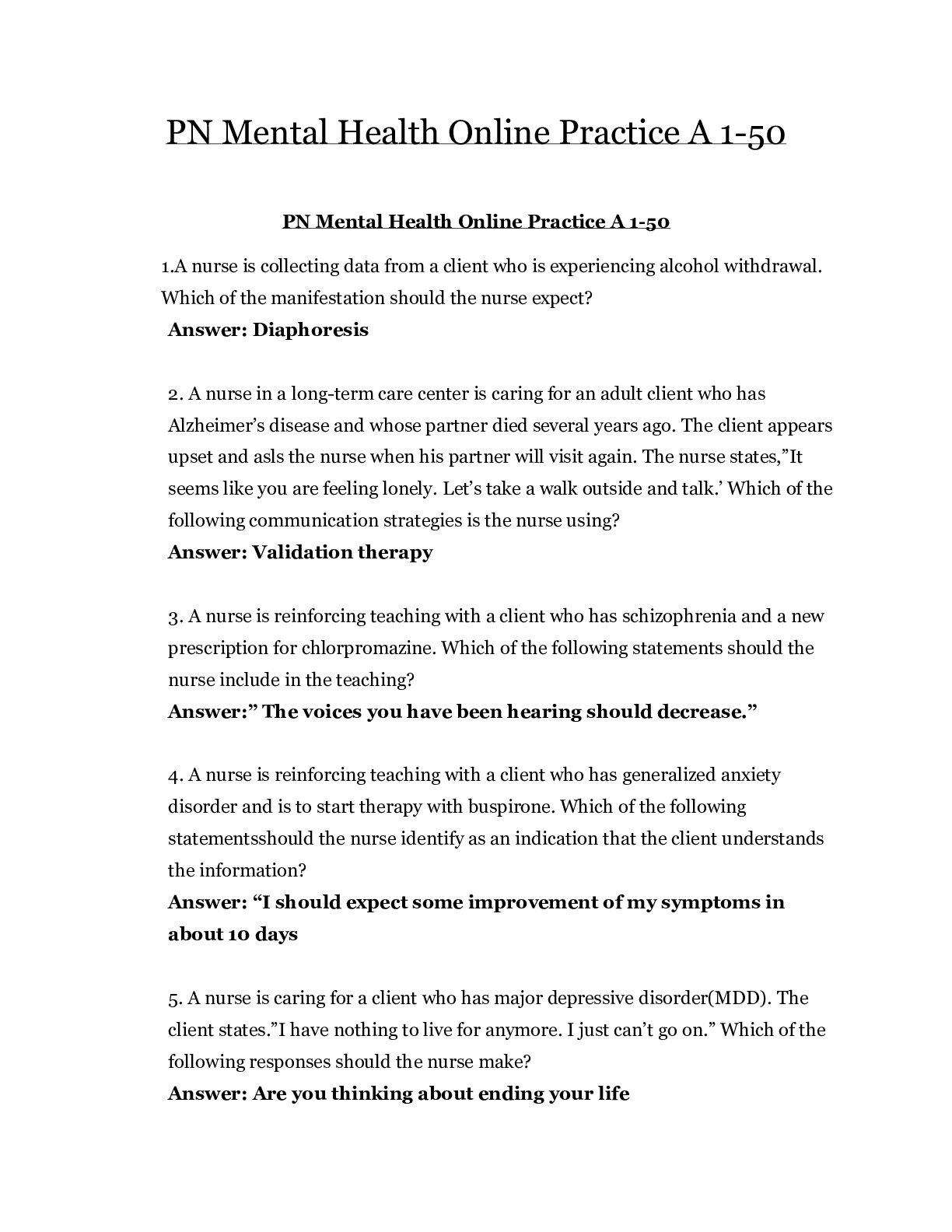
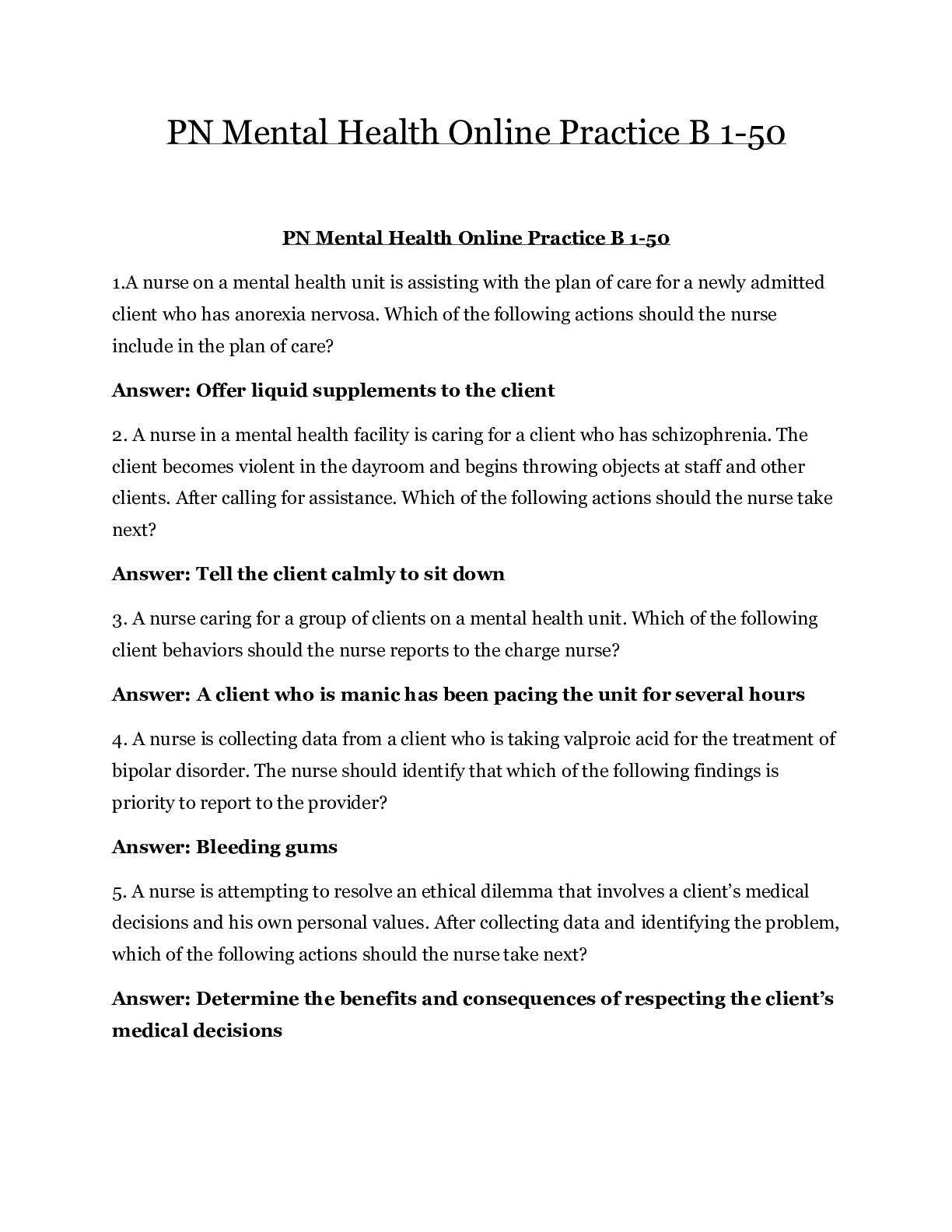
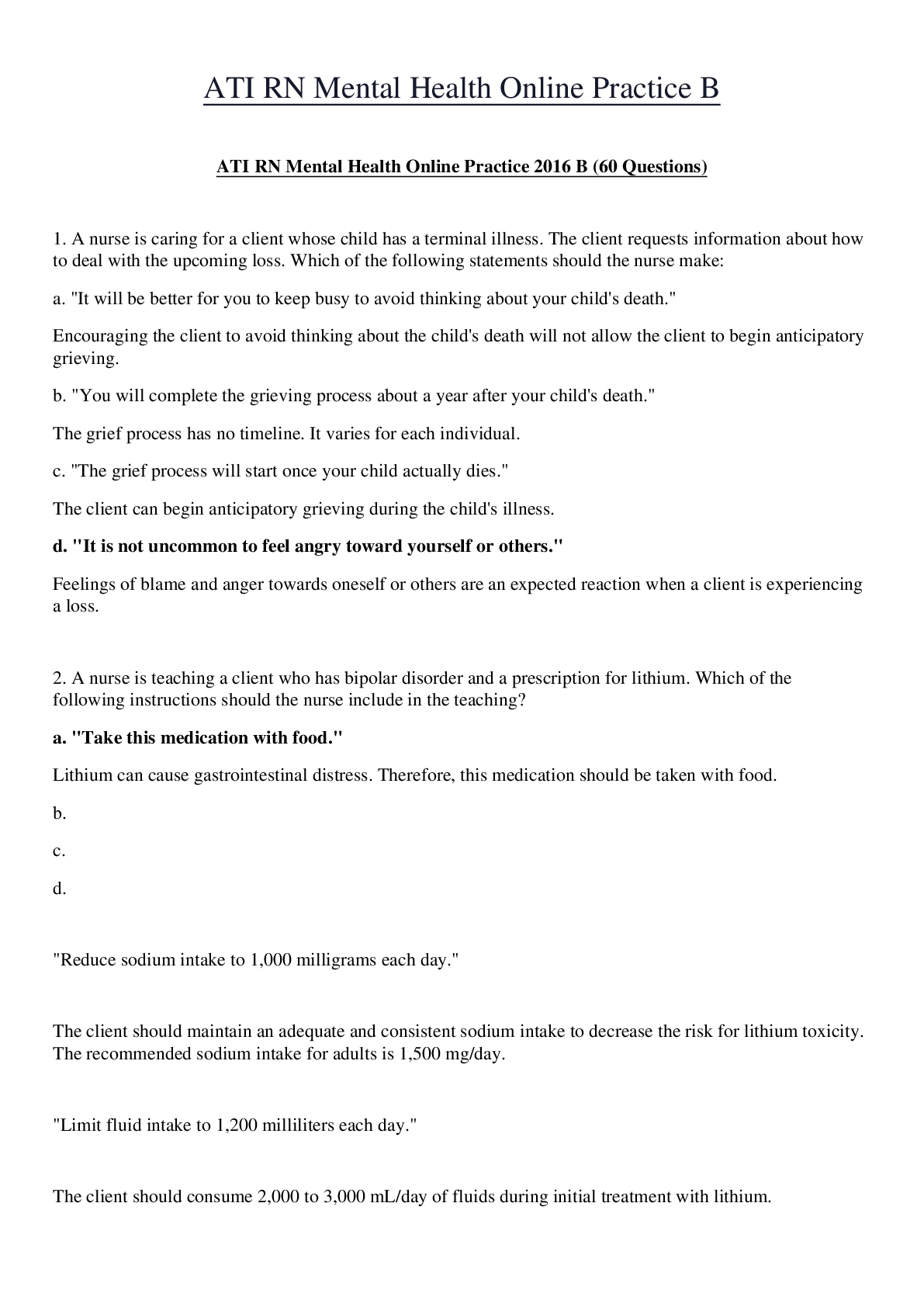


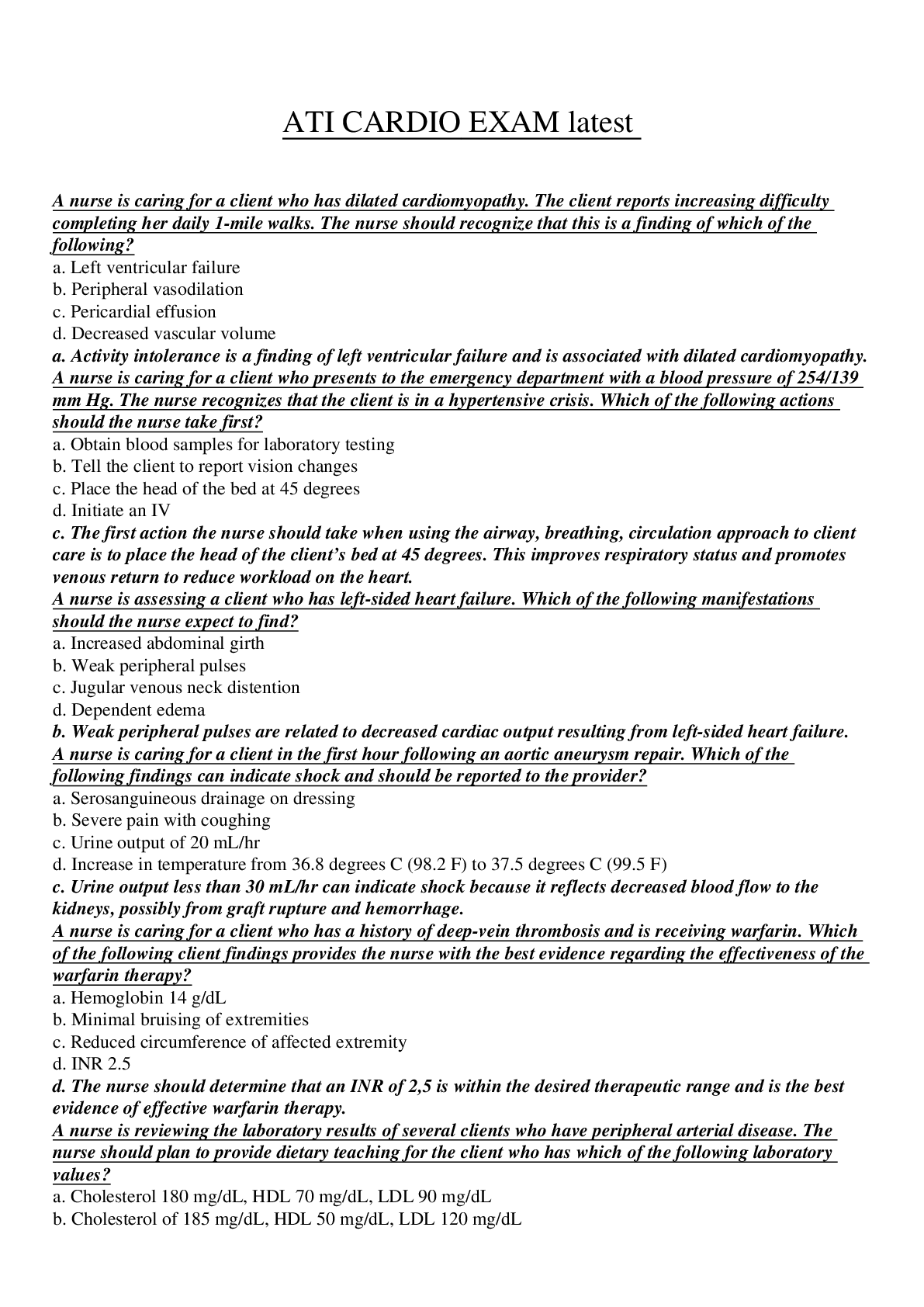
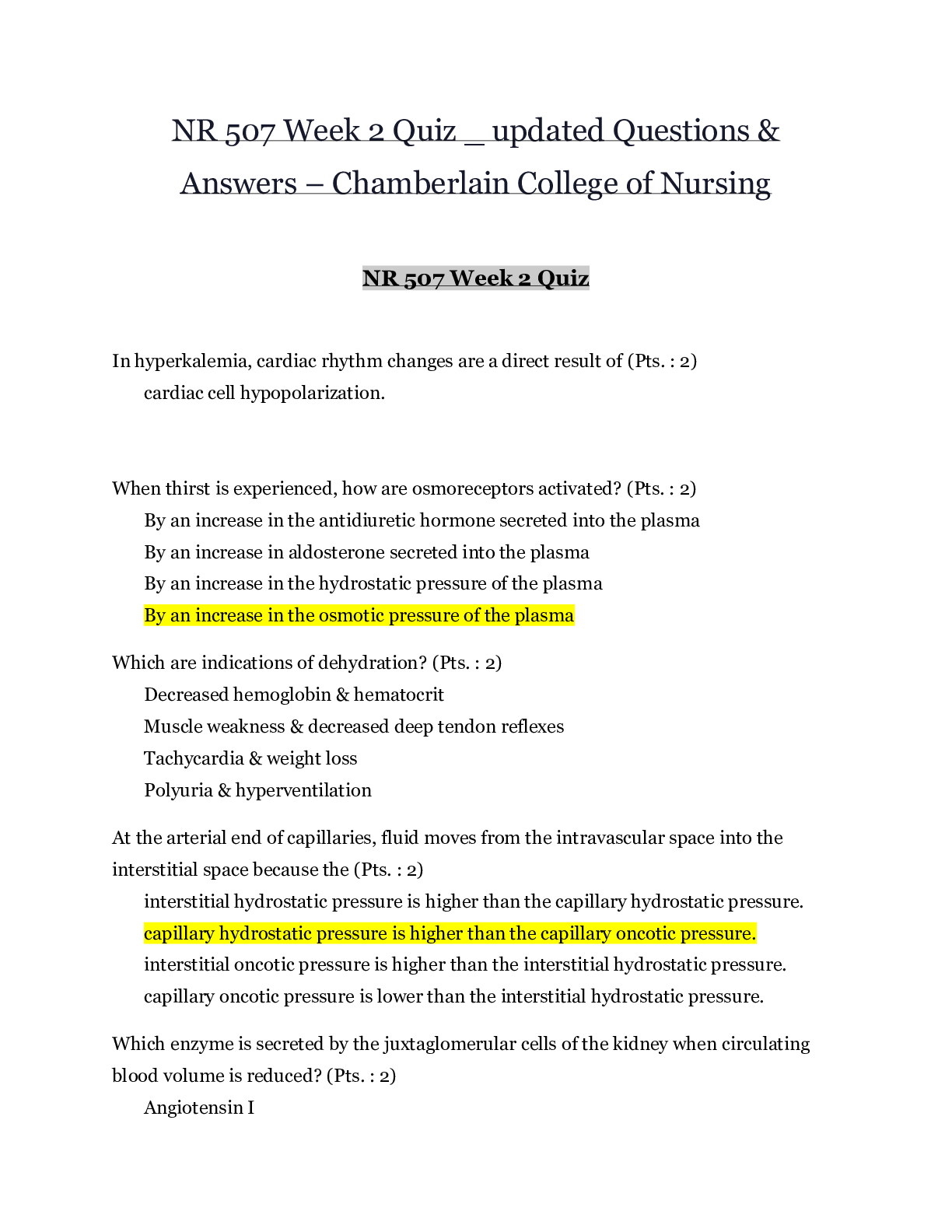
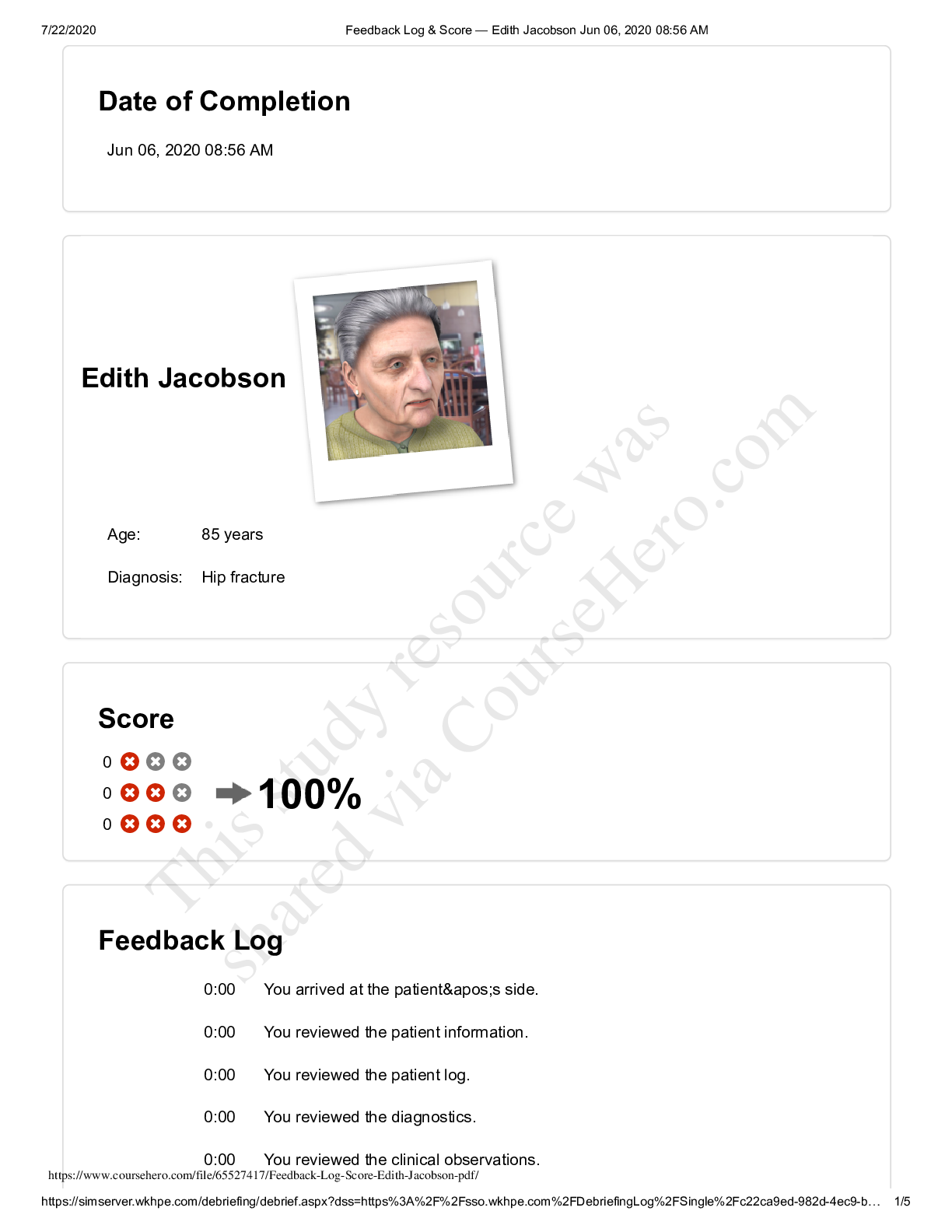
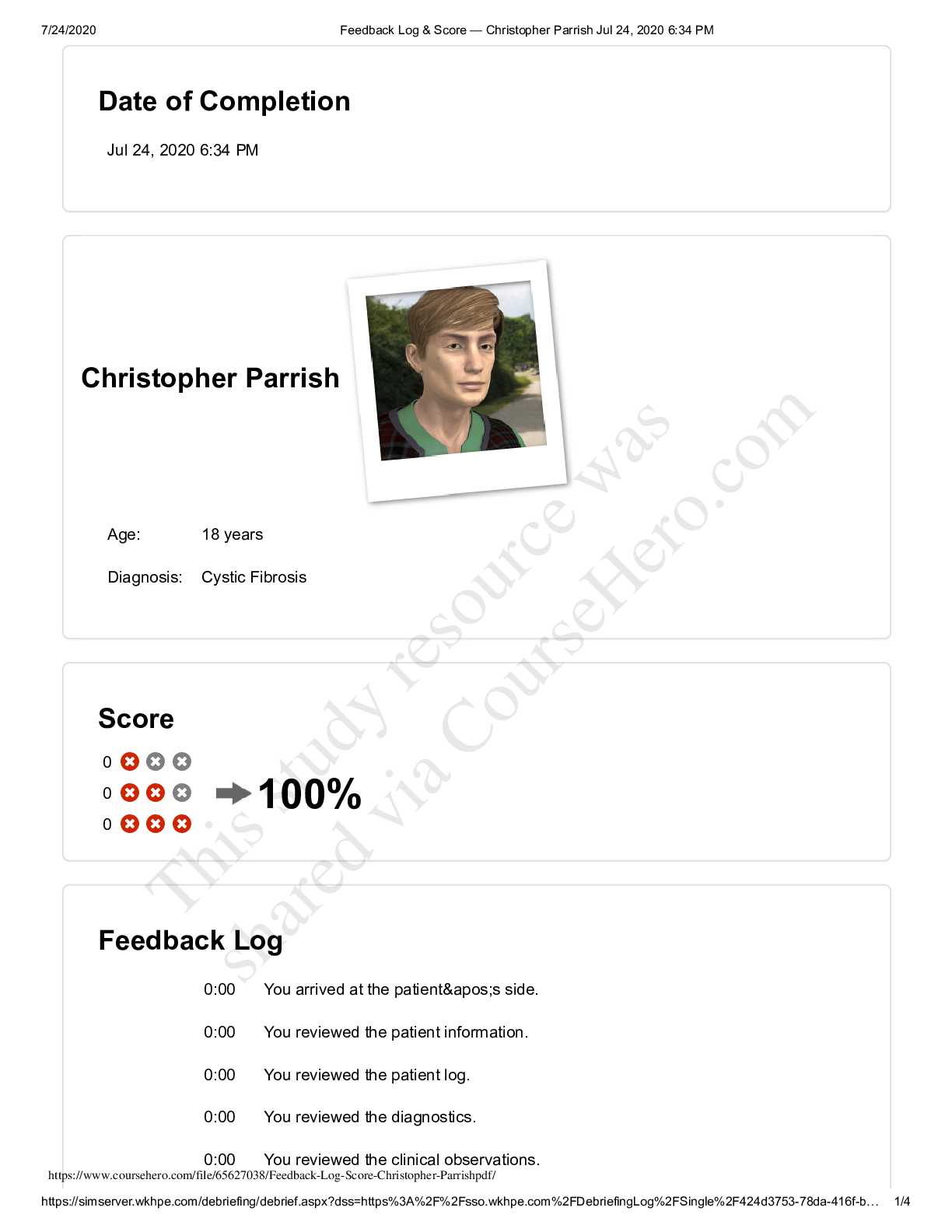
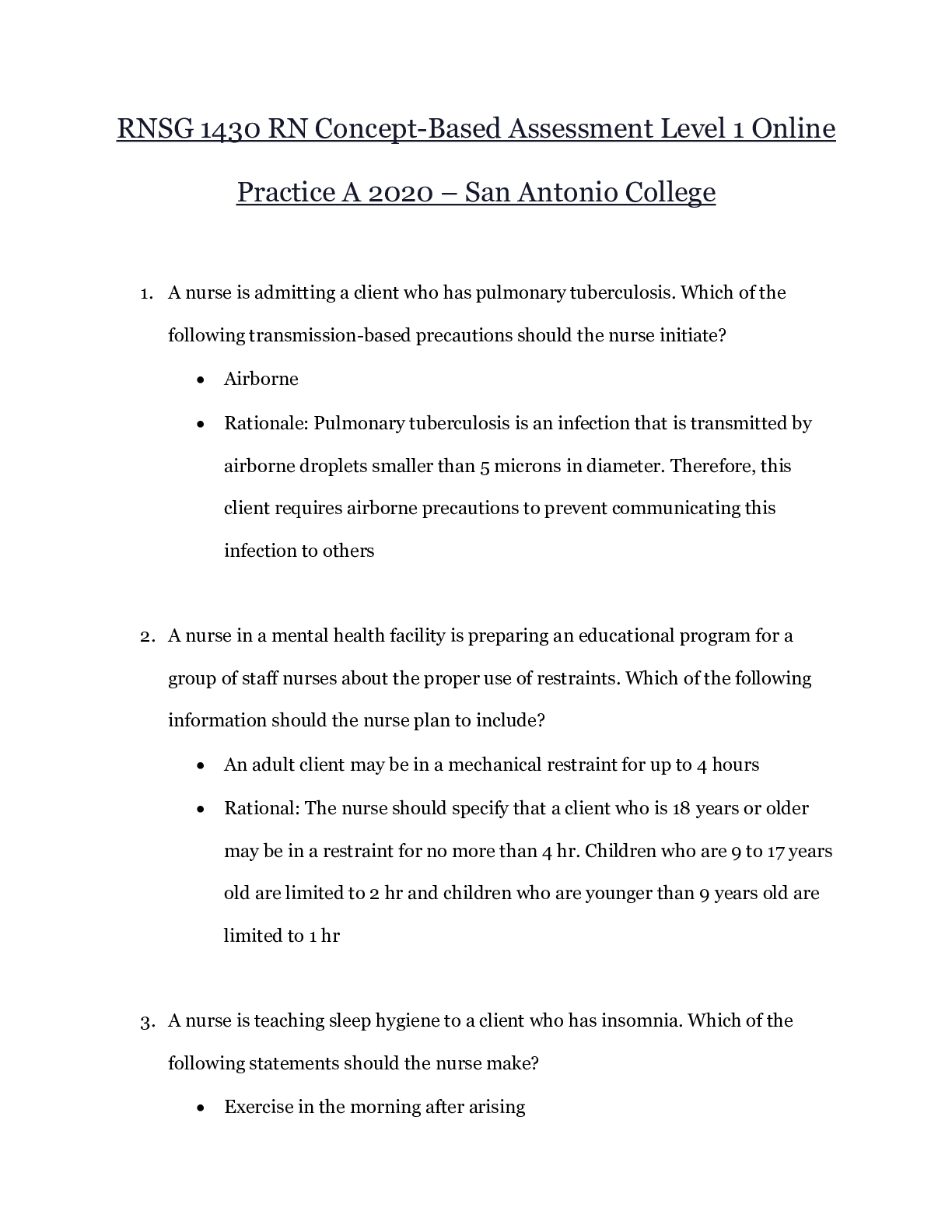


 – CHAMBERLAIN COLLEGE OF NURSING.png)


